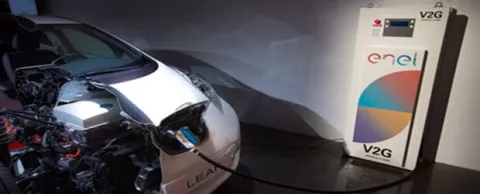
Council Associate Partner Enel and car maker Nissan have been working on vehicle-to-grid (V2G) technology for some time and are now ready to put it through a trial in the UK. The two companies have conducted successful trial projects before in other countries, but are likely being very cautious about the two-way charging technology for a few important reasons. Not all countries are the same and their regulations governing who can provide power to the electric grid aren't either. Also, it takes a large number of vehicles for a V2G system to perform as it should.
However, the idea that vehicles drawing power from the grid can send it back as needed to help cities and utilities manage their energy networks (and increasing amounts of renewable energy) is certainly an interesting concept, and worth following. — Doug Peeples
Nissan, manufacturer of the popular Leaf EV, and Enel, the second largest energy company in Europe, plan to install and connect V2G units at 100 locations for private and fleet owners of Leaf cars and e-NV200 electric vans. The companies say it is the first V2G trial in the UK.
One benefit for EV owners is that they will be able to sell power stored in their vehicle batteries back to the electric grid, which the two companies say will mean EV drivers are contributing to grid stability and making some money when they do.
How V2G technology could help cities manage energy
The technology, of course, is about far more than simply giving EV owners the opportunity to make a little money. Enel and Nissan use words like "revolutionize" to describe the impact their technology could have on energy management.
"Today's landmark trial in the UK is a significant step forward in renewable energy management, helping shape the future of industries, cities and societies. Smart energy management is one of the biggest challenges any nation faces for the future which is why this trial is so critical in assessing the feasibility of using variable, more flexible energy sources. We see Nissan vehicles as being the mobile energy hubs of the future, pioneering a self-sustaining energy infrastructure that will help solve the capacity issues of the future," said Nissan Europe Chairman Paul Willcox.
Ernesto Ciorra, head of Innovation and Sustainability for Enel, shared a different perspective: "The installation of our innovative two-way charging technology will encourage the integration of non-programmable renewable energy flow into the grid and will help the spread of electric mobility in the country, benefitting the energy sector and the environment, while also having a positive impact on electric owners' wallets."
How would two-way charging technology encourage renewable energy integration? V2G systems could act as buffers for intermittent solar and wind power, storing it when plenty is available and sending it back to the grid as needed. And large numbers of EV fleet cars and vehicles — such as buses, which have far larger batteries — can help add capacity to the grid when they're plugged in at night.
Related articles…
Vehicle-to-grid energy storage: One step closer to reality in Europe
Cities that need energy storage (batteries) can soon turn to Daimler
Doug Peeples is a Portland, Oregon-based writer specializing in technology and energy. Follow @smartccouncil on Twitter.



